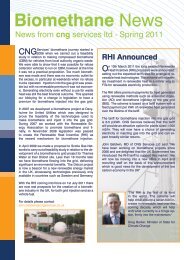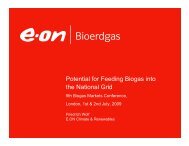Bio-SNG - CNG Services
Bio-SNG - CNG Services
Bio-SNG - CNG Services
You also want an ePaper? Increase the reach of your titles
YUMPU automatically turns print PDFs into web optimized ePapers that Google loves.
BIO-<strong>SNG</strong> FEASIBILITY STUDY – ESTABLISHMENT OF A REGIONAL PROJECTsupport to demonstrate <strong>Bio</strong>-<strong>SNG</strong> production. At 300MWth, a gasification facility configured to generateelectricity is likely to be commercially preferable to one configured to produce <strong>Bio</strong>-<strong>SNG</strong>, unless theRenewable Heat Incentive is significantly higher than the £40/MWh proposed.Carbon savingsA full lifecycle analysis of <strong>Bio</strong>-<strong>SNG</strong> production undertaken by North Energy Associates 7 shows that formany types of feedstock, the lifecycle CO 2 e savings of <strong>Bio</strong>-<strong>SNG</strong> compared with fossil fuel alternatives aretypically ~90%. This saving is similar for both conventional heating and transport applications. The annualCO 2 e savings for three of the larger facilities operating on biomass is 1Mte of CO 2 e per annum if used todisplace natural gas heating, and slightly higher if it displaces conventional transport fuel. If <strong>Bio</strong>gas wereto displace a third of the domestic natural gas consumption and bio-<strong>SNG</strong> represented two thirds of that,then the CO2e savings would be ~15Mte pa when fuelled by biomass.This analysis also demonstrates that the savings for the <strong>Bio</strong>-<strong>SNG</strong> production route are very similar tothose achieved using direct biomass heating. Given that the <strong>Bio</strong>-<strong>SNG</strong> solution has much lower demandsideconstraints and therefore could achieve greater market penetration, it is an attractive route.Cost of carbon abatedStrategically the UK needs to consider the most cost effective approach for decarbonising. An analysishas been undertaken which considers the cost of decarbonising, based on the current and proposedlevels of renewable support subsidy 8 considered to be adequate to achieve market penetration of theparticular technology.For heating applications using natural gas as a counterfactual, <strong>Bio</strong>-<strong>SNG</strong> offers a cost per tonne of CO 2 eabated of ~£175/te. This compares very favourably with direct biomass combustion for domesticapplications (£395/te), for small commercial applications (£285/te) but is somewhat more expensive thandirect biomass combustion for large scale commercial applications at ~£110/te. When using oil heating asthe counterfactual, the cost per tonne of CO 2 saved reduces significantly to £135/te for <strong>Bio</strong>-<strong>SNG</strong>compared with £305, £220 and £85 for the three cases discussed above. However it must be noted thatthe appropriate counterfactual for <strong>Bio</strong>-<strong>SNG</strong> is natural gas, as the product can only be used where there isa gas grid and where oil use is unlikely.7 “Analysis of the Greenhouse Gas Emissions for Thermochemical <strong>Bio</strong><strong>SNG</strong> Production and Use in the UnitedKingdom” Project Code NNFCC 10-009 Study funded by DECC and managed by NNFCC, North Energy Associates(June 2010)8 In deriving the cost of the emissions savings, the Government’s Impact Assessments calculation is made on thebasis of dividing the NPV of the incentive by the total tonnes of CO 2 abated. The analysis here is viewed from thepoint of view of the direct cost to the consumer, ie the subsidy cost divided by the tonnes of CO 2 saved, and wherepossible uses the full lifecycle emissions of CO 2 e.9









